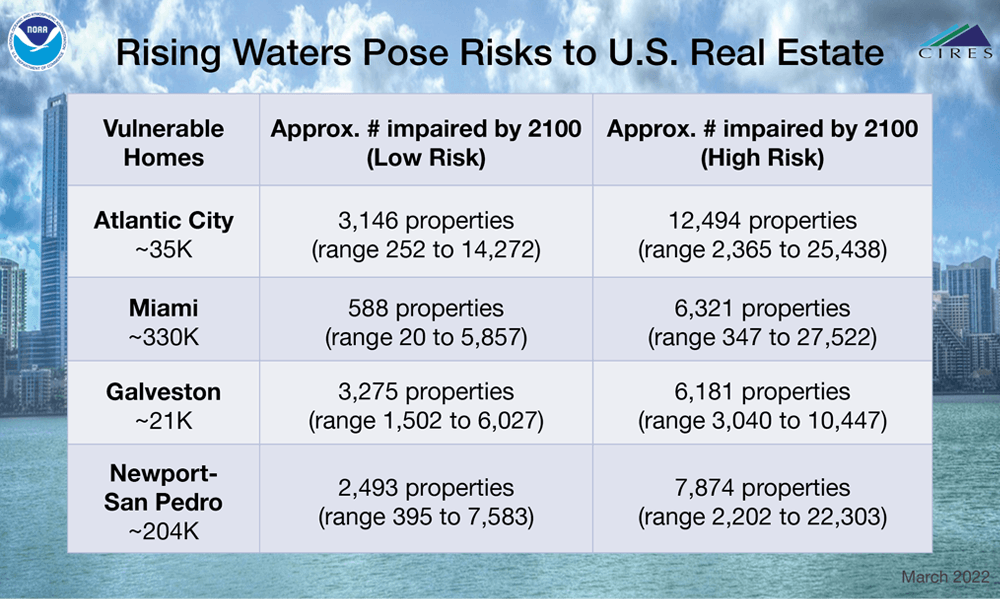Sea level rise threatens coastal housing markets
New study estimates potential losses at four U.S. locations

As sea level continues to rise, coastal properties across the country will be more prone to flooding in the coming decades—and the risk varies depending on location. A new study from researchers at the Federal Reserve Bank of Kansas City, MO, CIRES and NOAA’s National Centers for Environmental Information examined how rising sea levels could impact four U.S. coastal metro areas: Atlantic City, NJ; Miami, FL; Galveston, TX; and Newport–San Pedro, CA. The team published their findings in the journal Environmental Systems and Decisions.
A New Approach
Given that approximately 40 percent of the U.S. population lives in coastal communities, the study team set out to create an easy-to-replicate way to estimate the impact of sea level rise on thousands of homes in areas of concern.
Earth’s warming is expected to exacerbate rising coastal waters in the short- and long-term. Since 1880, sea level has risen 8–9 inches (21–24 centimeters), and in 2020 global sea level set a new record high—3.6 inches (91.3 millimeters) above 1993 levels—according to NOAA. In addition to sea-level-rise (SLR) projections, the researchers used data on housing characteristics, local topography, tidal conditions and elevation to quantify the potential impacts of sea level rise.
Their methodology relied on publicly available data to show 1) refined measurements of property inundation (the amount of water that occurs above normally dry ground as a result of flooding) elevation; 2) estimated timing of SLR inundation; and 3) SLR risk that accounted for variations in climate conditions.
“Our results provide an important perspective on the timing of future losses, the associated uncertainty and [the] asymmetry of risk from sea level rise inundation,” the research team stated.
Risks to Local Housing Markets Vary
The social, economic and financial costs due to SLR are expected to differ depending on many issues, including the extent of global greenhouse gas (GHG) emissions. The researchers offered a range of possible outcomes for the various locations regarding the timing, number of homes likely to be impacted and estimated value of those losses.

Using digital elevation models in the NOAA Sea-Level Rise Viewer and the nearest local sea-level projections for Permanent Service for Mean Sea-Level tidal stations, the researchers determined how many residences might be most prone to inundation in four U.S. coastal metro areas.
Examining single-family residences, townhomes and 2–4 unit residential buildings, the researchers identified the current elevation above sea level for about 590,000 homes in four metro areas selected for their geographic diversity.
Using digital elevation models (DEMs) in the NOAA Sea-Level Rise Viewer and the nearest local sea-level projections from Permanent Service for Mean Sea Level tidal stations, they determined which residences might be most prone to inundation.
The team based its calculations on a scenario of medium GHG emissions, known in the scientific community as RCP4.5 (Representative Concentration Pathway 4.5). The researchers also considered low- and high-risk factors to account for potential accelerated ice sheet loss, which could change outcomes in coastal communities. They estimated the number of impaired residential units rather than the relatively less-stable market (financial) values.
“Our risk-matching methods could be used by other researchers and practitioners to assess SLR risk in other coastal markets (e.g., commercial real estate) or for various housing strata and populations (e.g., owner-occupied vs. renters),” the authors concluded.
This story is adapted from one by NOAA NCEI.